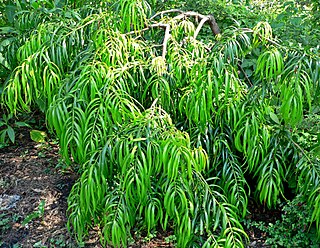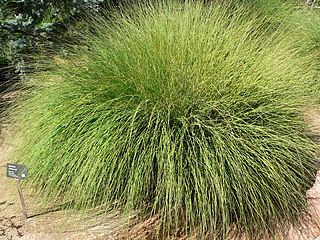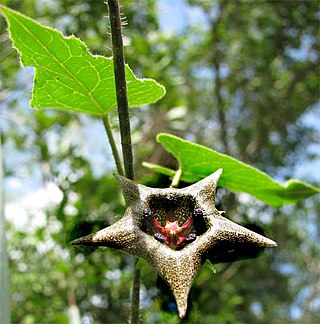Olmeca is a genus of Mesoamerican bamboo in the grass family.

Chusquea is a genus of evergreen bamboos in the grass family. Most of them are native to mountain habitats in Latin America, from Mexico to southern Chile and Argentina.

Tigridia, is a genus of bulbous or cormous flowering plants belonging to the family Iridaceae. With common names including peacock flowers, tiger-flowers or shell flowers, they have large showy flowers; and one species, Tigridia pavonia, is often cultivated for this. The approximately 60 species in this family grow in the Americas, from Mexico down to Chile.
Alvimia is a Brazilian genus of bamboo in the grass family. It is native to the eastern coastal regions of the State of Bahia in eastern Brazil.
- Alvimia auriculataSoderstr. & Londoño
- Alvimia gracilisSoderstr. & Londoño
- Alvimia lancifoliaSoderstr. & Londoño

Rhipidocladum is a genus of New World woody bamboo in the grass family). It found in Mesoamerica, Trinidad, and South America. The genus is characterized by 1) erect, non-pseudopetiolate culm leaves, 2) numerous branchlets arising in an aspidate (fan-like) array, and 3) fruits being true caryopses. The name is derived from the Greek rhipid meaning "fanlike" and clad meaning "branch".
- Rhipidocladum abregoensis - Colombia
- Rhipidocladum ampliflorum - Venezuela
- Rhipidocladum angustiflorum - Colombia, Venezuela
- Rhipidocladum bartlettii - Mexico, Belize, Guatemala, Honduras
- Rhipidocladum clarkiae - Costa Rica
- Rhipidocladum harmonicum - from southern Mexico to Bolivia
- Rhipidocladum martinezii - Mexico (Chiapas)
- Rhipidocladum maxonii - Costa Rica, Guyana
- Rhipidocladum neumannii - Argentina, Bolivia
- Rhipidocladum pacuarense - Nicaragua, Costa Rica
- Rhipidocladum panamense - Panamá
- Rhipidocladum parviflorum - Venezuela, Colombia, Perú, Bolivia, Brazil, Panamá
- Rhipidocladum pittieri - from Mexico (Michoacán) to Panamá
- Rhipidocladum prestoei - Trinidad
- Rhipidocladum racemiflorum - Mexico from Tucumán to Tamaulipas
- Rhipidocladum sibilans - Venezuela, Guyana

Eremocaulon is a genus of Brazilian bamboo in the grass family.
- Eremocaulon amazonicumLondoño - Acre, Amazonas, Rondônia
- Eremocaulon asymmetricum(Soderstr. & Londoño) Londoño - Bahia
- Eremocaulon aureofimbriatumSoderstr. & Londoño - Bahia, Minas Gerais
- Eremocaulon capitatum(Trin.) Londoño - Goiás, Mato Grosso, Mato Grosso do Sul
Events in the year 1934 in Mexico.

Podocarpus matudae is a species of conifer in the family Podocarpaceae. It is found in Guatemala, El Salvador, Honduras and Mexico.

Muhlenbergia is a genus of plants in the grass family.
Triniochloa is a genus of Latin American plants in the grass family.

Olyra is a genus of tropical bamboos in the grass family. It is native primarily to the Western Hemisphere, with one species extending into Africa.

Jouvea is a Latin American genus of coastal plants in the grass family. It grows on mud flats and coastal sand dunes from northern Mexico to Ecuador.

Tridax is a genus of flowering plants in the family Asteraceae.

Thomas Robert Soderstrom was an American agrostologist His special field of study was the grass family Gramineae or Poaceae. He was Curator of Grasses at the National Museum of Natural History in Washington, DC for some twenty years.
Prionosciadium is a genus in the carrot family, Apiaceae. It is endemic to Mexico. The plants are biennial herbs with large taproots.

Dictyanthus is a genus of plant in family Apocynaceae, first described as a genus in 1844. It is native to Mexico and Central America
Chondrosum is a genus of North American and South American plants in the grass family.
Cirsium mexicanum is a Mesoamerican and Caribbean species of plants in the tribe Cardueae within the family Asteraceae. Common name is Mexican thistle. It is widespread across Mexico, Central America and the West Indies.
Mexicana Universal 2020 was the 3rd edition of the Mexicana Universal beauty pageant held on November 29, 2020. 30 candidates from all over Mexico competed for the national title. Claudia Lozano of Nuevo León crowned Andrea Meza of Chihuahua at the end event. Meza represented Mexico at the Miss Universe 2020 pageant which she won to become the third Mexican Miss Universe.











